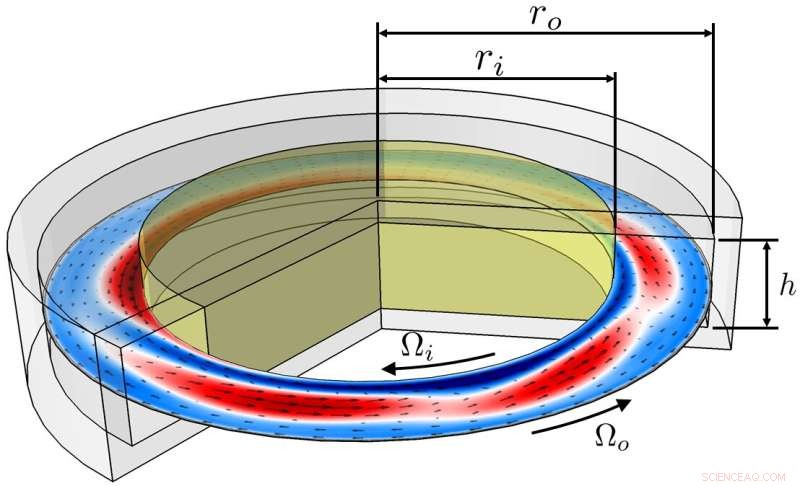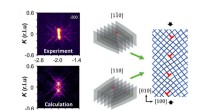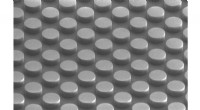
Wetenschap
Natuurkundigen ontdekken nieuw dynamisch raamwerk voor turbulentie

Het experiment van de onderzoekers bevatte transparante muren om volledige visuele toegang mogelijk te maken, en maakte gebruik van een ultramoderne stroomvisualisatie. Krediet:Foto:Michael Schatz
Turbulentie speelt een sleutelrol in ons dagelijks leven, zorgt voor hobbelige vliegtuigritten, beïnvloedt weer en klimaat, beperkt het brandstofverbruik van de auto's waarin we rijden en heeft een impact op technologieën voor schone energie. Toch hebben wetenschappers en ingenieurs gepuzzeld over manieren om turbulente vloeistofstromen te voorspellen en te veranderen, en het is lang een van de meest uitdagende problemen in wetenschap en techniek gebleven.
Nu hebben natuurkundigen van het Georgia Institute of Technology aangetoond - numeriek en experimenteel - dat turbulentie kan worden begrepen en gekwantificeerd met behulp van een relatief kleine reeks speciale oplossingen voor de heersende vergelijkingen van vloeistofdynamica die vooraf kunnen worden berekend voor een bepaalde geometrie, voor eens en voor altijd.
"Al bijna een eeuw wordt turbulentie statistisch beschreven als een willekeurig proces", zegt Roman Grigoriev. "Onze resultaten bieden de eerste experimentele illustratie dat, op geschikte korte tijdschalen, de dynamiek van turbulentie deterministisch is - en deze verbindt met de onderliggende deterministische heersende vergelijkingen."
De bevindingen zijn gepubliceerd in Proceedings of the National Academy of Sciences op 19 augustus 2022. Het team van onderzoekers werd geleid door Grigoriev en Michael Schatz, professoren aan de School of Physics van Georgia Tech, die de afgelopen twee decennia hebben samengewerkt aan verschillende onderzoeksprojecten.
Schatz en Grigoriev werden in het onderzoek vergezeld door afgestudeerde studenten van de School of Physics Chris Crowley, Joshua Pughe-Sanford en Wesley Toler, samen met Michael Krygier, een postdoctoraal wetenschapper bij Sandia National Laboratories, die de numerieke oplossers van de studie ontwikkelde als een afgestudeerde student aan Georgia Tech.

Dankzij de opstelling konden de onderzoekers de stroom reconstrueren door de beweging van miljoenen gesuspendeerde fluorescerende deeltjes te volgen. Krediet:Foto:Michael Schatz
Een nieuwe 'roadmap' voor turbulentieonderzoek
Het kwantitatief voorspellen van de evolutie van turbulente stromingen - en in feite bijna elk van hun eigenschappen - is nogal moeilijk. "Numerieke simulatie is de enige betrouwbare bestaande voorspellingsaanpak," zei Grigoriev. "Maar het kan erg duur zijn. Het doel van ons onderzoek was om voorspellingen goedkoper te maken."
De onderzoekers creëerden een nieuwe "routekaart" van turbulentie door te kijken naar een zwakke turbulente stroming die was opgesloten tussen twee onafhankelijk roterende cilinders - waardoor het team een unieke manier kreeg om experimentele waarnemingen te vergelijken met numeriek berekende stromingen, vanwege de afwezigheid van "eindeffecten" die aanwezig zijn in meer bekende geometrieën, zoals stroming door een pijp.
"Turbulentie kan worden gezien als een auto die een reeks wegen volgt", zei Grigoriev. "Misschien is een nog betere analogie een trein, die niet alleen een spoorlijn volgt volgens een voorgeschreven dienstregeling, maar ook dezelfde vorm heeft als de spoorlijn die hij volgt."
Het experiment had transparante wanden om volledige visuele toegang mogelijk te maken, en het gebruikte een ultramoderne stroomvisualisatie om de onderzoekers in staat te stellen de stroom te reconstrueren door de beweging van miljoenen gesuspendeerde fluorescerende deeltjes te volgen. In parallel, advanced numerical methods were used to compute recurrent solutions of the partial differential equation (Navier-Stokes equation), governing fluid flows under conditions exactly matching experiment.
It is well-known that turbulent fluid flows exhibit a repertoire of patterns—referred to as "coherent structures" in the field—that have a well-defined spatial profile but appear and disappear in an apparently random manner. By analyzing their experimental and numerical data, the researchers discovered that these flow patterns and their evolution resemble those described by the special solutions they computed. These special solutions are both recurrent and unstable, meaning they describe repeating flow patterns over short intervals of time. Turbulence tracks one such solution after another, which explains what patterns can appear, and in what order.

A schematic of the physicists' research. Credit:Michael Schatz, Roman Grigoriev.
Recurrent solutions, two frequencies
"All the recurrent solutions that we found in this geometry turned out to be quasi-periodic—that is, characterized by two different frequencies," said Grigoriev. One frequency described the overall rotation of the flow pattern around the axis of symmetry of the flow, while the other described the changes in the shape of the flow pattern in a reference frame co-rotating with the pattern. The corresponding flows repeat periodically in these co-rotating frames.
"We then compared turbulent flows in experiment and direct numerical simulations with these recurrent solutions and found turbulence to closely follow (track) one recurrent solution after another, for as long as turbulent flow persisted," Grigoriev said. "Such qualitative behaviors were predicted for low-dimensional chaotic systems, such as the famous Lorenz model, derived six decades ago as a greatly simplified model of the atmosphere."
The work represents the first experimental observation of chaotic motion tracking recurrent solutions actually observed in turbulent flows. "The dynamics of turbulent flows are, of course, far more complicated due to the quasi-periodic nature of recurrent solutions," Grigoriev added.
"Using this method, we conclusively showed that the organization of turbulence in both space and time is well captured by these structures," the researchers said. "These results lay the foundation for representing turbulence in terms of coherent structures and leveraging their persistence in time to overcome the devastating effects of chaos on our ability to predict, control, and engineer fluid flows."
A new dynamical foundation for 3D fluid flows
These findings most immediately impact the community of physicists, mathematicians, and engineers who are still trying to understand fluid turbulence, which remains "perhaps the greatest unsolved problem in all of science," Grigoriev said.
"This work builds and expands on previous work on fluid turbulence by the same group, some of which was reported at Georgia Tech in 2017," he added. "Unlike the work discussed in that publication, which focused on idealized two-dimensional fluid flows, present research addresses the practically important and more complicated three-dimensional flows."
Ultimately, the team's study lays a mathematical foundation for fluid turbulence which is dynamical, rather than statistical, in nature—and hence has the capability to make quantitative predictions, which are crucial for a variety of applications.
"It can give us the ability to dramatically improve the accuracy of weather forecasts and, most notably, enable prediction of extreme events such as hurricanes and tornadoes," said Grigoriev. "Dynamical framework is also essential for our ability to engineer flows with desired properties, for instance, reduced drag around vehicles to improve fuel efficiency, or enhanced mass transport to help remove more carbon dioxide from the atmosphere in the emerging direct air capture industry." + Verder verkennen
Researchers reveal multi-scale characteristics of helicity in wall-bounded turbulent flows
 Team presenteert nieuwe synthesemethode voor klikchemie
Team presenteert nieuwe synthesemethode voor klikchemie Blaarvloeistof kan helpen bij het diagnosticeren van de ernst van brandwonden
Blaarvloeistof kan helpen bij het diagnosticeren van de ernst van brandwonden Antireflecterende coating van brillen verwijderen
Antireflecterende coating van brillen verwijderen  Tumbleweeds of fibrillen:Tau-eiwitten moeten kiezen
Tumbleweeds of fibrillen:Tau-eiwitten moeten kiezen Een reactie waarbij licht en twee overgangsmetaalkatalysatoren worden gebruikt om anilinen te maken
Een reactie waarbij licht en twee overgangsmetaalkatalysatoren worden gebruikt om anilinen te maken
Hoofdlijnen
- De centrale hoek vinden
- Vier grote groepen organische verbindingen die levende organismen samenstellen
- Wetenschappers controleren cellen met licht,
- Anti-verouderingsbehandelingen - de wetenschap van het leven langer
- Welk deel van het Nephron is verantwoordelijk voor de reabsorptie van water?
- Milieubeheer van inheemse naties bij het aanpakken van invasieve soorten
- Entomoloog ontdekt ongewervelde dieren die in meer kleurencombinaties voorkomen dan alle andere
- Science Fair-projecten met nagellak
- Wat zijn de rollen van chlorofyl A & B?
- Quantum computing:koude chips kunnen qubits besturen

- Geautomatiseerde uitlijning van optische vezels vermindert fouten en kosten bij de productie van fotonische chips

- Geïnduceerde gebreken in kwantummaterialen kunnen supergeleidende eigenschappen verbeteren

- 'S Werelds record verstrengeling opslag vormt een mijlpaal voor Quantum Internet Alliance

- Elektromagnetische energie absorberen terwijl de hitte wordt vermeden

 Aluminiumcomplexen geïdentificeerd via vibrationele vingerafdrukken
Aluminiumcomplexen geïdentificeerd via vibrationele vingerafdrukken Wormen in het ecosysteem
Wormen in het ecosysteem  Welke twee planeten hebben gigantische stormen op zich?
Welke twee planeten hebben gigantische stormen op zich?  Hoe een Pareto-grafiek
Hoe een Pareto-grafiek Stijgende zeespiegels zullen in sommige gebieden tot matige overstromingen leiden, ernstige overstromingen in anderen
Stijgende zeespiegels zullen in sommige gebieden tot matige overstromingen leiden, ernstige overstromingen in anderen Europese kolonisatie versnelde erosie vertienvoudigd
Europese kolonisatie versnelde erosie vertienvoudigd Lijst met de voordelen van wrijving
Lijst met de voordelen van wrijving  Studie documenteert dat boomsoorten achteruit gaan door klimaatopwarming
Studie documenteert dat boomsoorten achteruit gaan door klimaatopwarming
- Elektronica
- Biologie
- Zonsverduistering
- Wiskunde
- French | Italian | Spanish | Portuguese | Swedish | German | Dutch | Danish | Norway |

-
Wetenschap © https://nl.scienceaq.com

